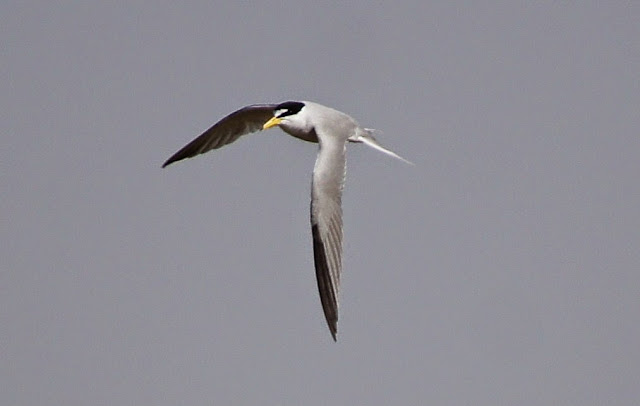The Glendale Recharge Ponds is a chill place for birds and birders. It's a fun place for me to meet up with people and enjoy a lot of birds with as minimum of time as possible. Because I can be at Glendale in 15-20 minutes, I have had a list of 200 species at the ponds for quite some time. During the last few days, I've added two more, a female Wood Duck and a fly-over male Broad-tailed Hummingbird that Sean Fitzgerald and I heard. So my home birding location, the Glendale Recharge Ponds, now has a list that stands at 202. Seeing shorebirds, gulls, terns, and more, at this time of year make Glendale a fun stop! This Solitary Sandpiper is one such example, which was located by it's loud two-tone call note.
One of the draws here lately has been a few Black-bellied Plovers that have showed up at the pond. 1-2 of them died, and the other two stuck around together for a few days. One of them was a bright male while the other was more monotone. The monotone has been around still to this very hour, I think it may call Glendale it's home for a while longer. Here is Mr. Brightside with a Western and Least Sandpipers, cool looking bird huh?
The Black-bellied Plover is a species that I haven't seen much of prior to these individuals showing up. I only had 3-4 observations for my life previously, so seeing this bright male was quite the highlight for me!
When I was birding with my buddy Mark Ochs, we stumbled upon a Marbled Godwit. I think the Marbled Godwit, or just any Godwit in general, lies among my favorites in the shorebird department. This Marbled Godwit was feasting with Black-necked Stilts.
A bonus surprise at the Glendale Recharge Ponds has been a Great Horned Owl nest nearby, which plenty of birders have been able to enjoy.
American Avocets have been looking nice.
The small Semipalmated Plover is also another one to keep our eyes out for at this time of year. Mark Ochs and I counted 8 of them in one small area.
And here's another Solitary Sandpiper. Mark and I found it in the canal which lines the eastern side of the Glendale Recharge Ponds.
As I mentioned earlier, my buddy Eric joined me at the Glendale Recharge Ponds after the big owling excursion. After showing Eric his first ever selection of waterbirds, I got to show him his first ever Bald Eagle flying over the Glendale Recharge Ponds and seemingly scaring up every bird. Eric didn't even think it was real at first. The sight of the Bald Eagle still amazes me today, and it's crazy to see one in the middle of a big city.
Around showing Eric a variety of different waterfowl, shorebirds, and more waterbirds, we focused a lot of the expedition of looking for owls. I showed him the young Great Horned Owls near the Glendale Recharge Ponds, and they cooperatively sat right out in the open for us.
As we were enjoying the young Barn Owls, we eventually noticed that the mother was looking over her young and had an overview of her four fledglings. The adult female Barn Owl has a buffy breast while the male has a plain white breast. Despite looking, we failed to find the male, who is usually pretty shy.
For the last several years at the Glendale Recharge Ponds, I have seemed to miss the Least Terns that have showed up there after seeing them during the calendar years of 2009 through 2011. When Eric and I got to the Ponds before our owl search, Eric spied a Least Tern flying southwest that we had brief looks at and never got to see again. During the next morning, I joined Sean Fitzgerald for a few hours at the Ponds and we were hoping for some interesting birds. The morning became interesting when we heard a male Broad-tailed Hummingbird trilling overhead. We then saw from a distance that there were two Forster's Terns over Basin 3, and then Sean spied a single Least Tern. Once we got closer to the terns, we met up with Moe Bertrand and the three of us enjoyed the two terns species, as well as the continuing Black-bellied Plover. At first, we had a Forster's Tern drop by, up close and awesome.
The Forster's Tern is rather small/medium sized, and the Least Tern is so small it makes the Forster's Tern look like a giant.
With it's small size, the Least Tern is easily overlooked at times.
Sean, Moe, and I figured out where the Least Tern was feeding at and we spent the following hour waiting for and then watching it catch small fish out of the water. The Least Tern is the smallest tern in North America, so it is properly named! I felt very fortunate to see and photograph this bird up close like we did yesterday.
Thanks to my many friends who I have birded with lately!

































Awesome post! What a nice assortment of birds. It's wonderful that you were able to share some of your bird craft with the group. That Black-bellied Plover would be a good one to see. Good birding!
ReplyDelete